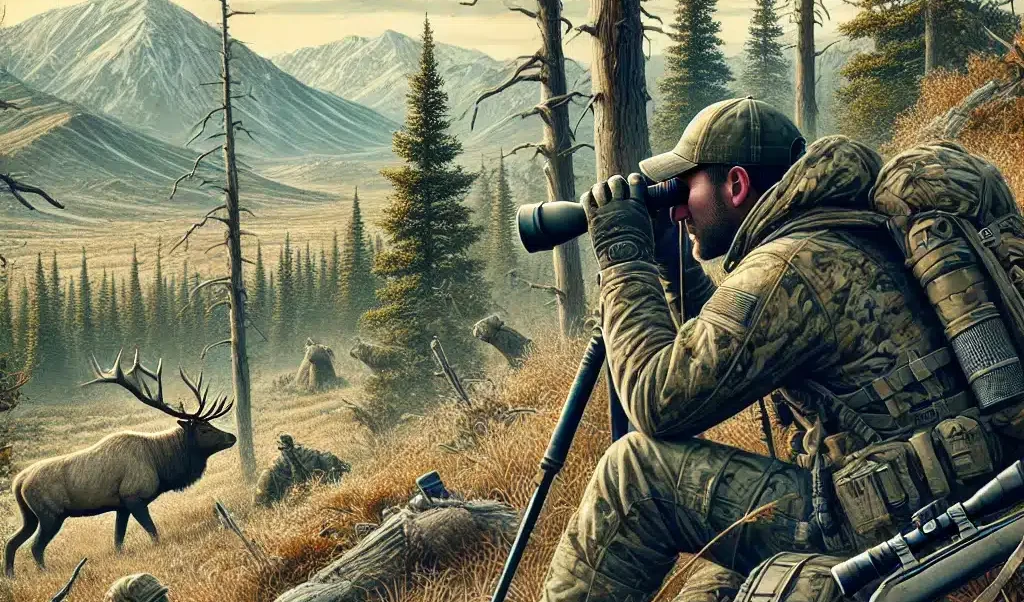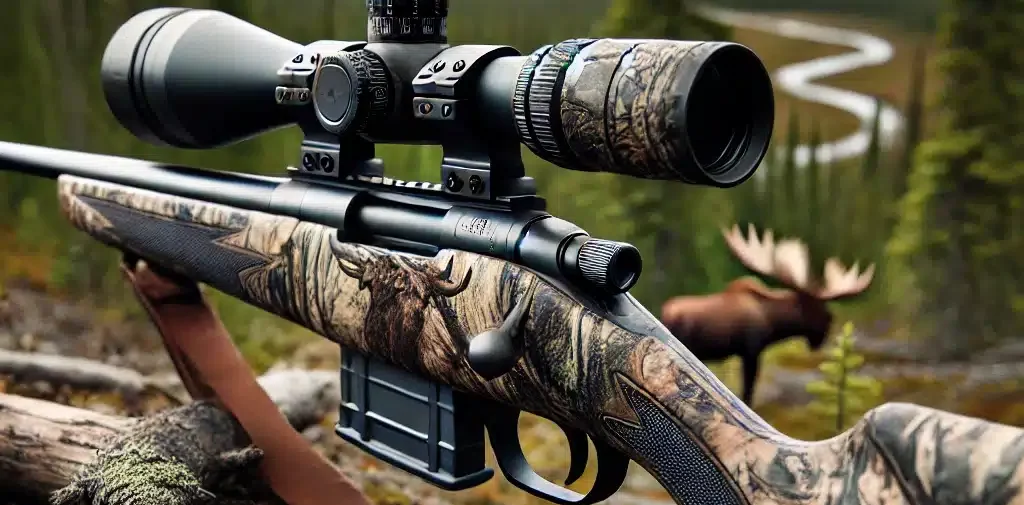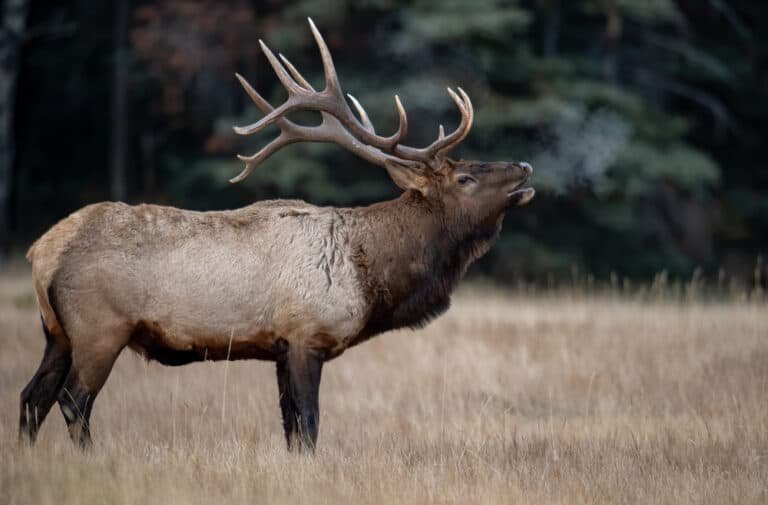7 Elk Hunting Tips for Beginners: Lessons in Success
Elk hunting, an exhilarating pursuit for outdoor enthusiasts, has gained immense popularity. Roaming the vast and majestic landscapes of North America, elk embody the essence of wildness and challenge. We’ve put together seven elk hunting tips for beginners to jump-start your success.

As one ventures into the realm of elk hunting, they are bound to experience the thrill of tracking these magnificent creatures through dense forests and across rugged terrains. However, this endeavor requires more than a sheer passion for adventure; it demands meticulous preparation and comprehensive knowledge to achieve a successful hunt.
Elk Hunting as a Popular Outdoor Activity
Elk hunting has captured the hearts and imaginations of hunters worldwide due to several factors. First and foremost is its grandeur—seeing a massive bull elk standing tall with majestic antlers against a backdrop of picturesque wilderness is awe-inspiring. Moreover, elk meat is highly sought for its exceptional quality, rich taste, and nutritional value.
The satisfaction derived from harvesting one’s organic food adds a layer of gratification to the hunt. Furthermore, elk hunting offers an unparalleled opportunity to immerse oneself in nature’s splendor.
From traversing vast mountain ranges to navigating dense forests or stalking silently through expansive meadows—each quest leads hunters on an unforgettable journey amidst breathtaking landscapes. Additionally, elk hunting provides an escape from the stresses of modern life while promoting physical fitness and mental resilience.
Proper Preparation and Knowledge for a Successful Hunt
While pursuing wild game demands careful planning and proficiency, proper preparation is paramount for elk hunting. It entails acquiring essential skills such as marksmanship or archery proficiency to ensure ethical kills that prioritize both safety and respect for wildlife.
Understanding ballistics, trajectory calculations, and wind deflection measurements are crucial factors contributing to successful shots on target. Moreover, comprehensive knowledge about elk behavior is vital in strategizing hunting techniques.
Familiarizing oneself with elk habitats, seasonal patterns, and migration routes enables hunters to identify prime locations for scouting and increase their chances of encountering these majestic animals. Additionally, understanding the intricacies of rutting behavior and mastering vocalizations can prove invaluable when attempting to deceive bulls into range during the breeding season.
Elk hunting represents a thrilling adventure embraced by outdoor enthusiasts worldwide. The allure of this pursuit lies not only in its grandeur but also in the opportunity it provides to connect with nature and procure sustainable food sources.
However, it is imperative to acknowledge that success in elk hunting hinges upon meticulous preparation and a comprehensive understanding of these magnificent creatures’ behaviors and habitats. By embarking on this journey with knowledge and honed skills, hunters can elevate their experiences while upholding ethical practices that ensure safety and conservation.
Understanding Elk Behavior

Elk habitats and preferred terrain
Elks are majestic creatures that thrive in a variety of habitats across North America. They are primarily found in mountainous regions, such as the like mountains, where the terrain provides ample cover and resources.
These magnificent animals prefer areas with a mix of open meadows for grazing and dense forests for shelter. They are often spotted near water sources like rivers, lakes, or marshes, as water access is vital for survival.
When it comes to their preferred terrain, elks tend to favor rugged landscapes with varying elevations. Steep slopes and canyons offer protection, allowing them to move freely between feeding grounds and bedding areas.
Valleys that provide both food and cover serve as hotspots for elk activity. Understanding these habitat preferences is essential for hunters aiming to locate elk herds during their hunting expeditions.
Seasonal patterns and migration routes
Elks exhibit distinct seasonal patterns influenced by weather conditions and available food sources. In the spring and summer months, they typically inhabit higher elevations where fresh vegetation thrives.
As autumn approaches, they begin migrating to lower elevations in search of more abundant food resources before the onset of winter. Migration routes play a significant role in successful elk hunting.
These routes connect summer ranges with winter ranges, providing vital information on where hunters should focus their efforts during specific times of the year. Conducting thorough research or consulting local wildlife authorities can help identify these migration corridors accurately.
Rutting behavior and vocalizations
The rutting season is an exciting time for elk hunters as it presents unique opportunities to encounter trophy bulls engaging in intense mating behaviors. Understanding the intricacies of elk rutting behavior is crucial for maximizing hunting success during this period.
During the rut, bull elks engage in fierce competition by bugling and displaying aggressive behaviors to establish dominance and attract potential mates. Bugling is a vocalization technique that resonates across the mountains, serving as a powerful tool for locating bull elk.
It is a deep, resonant sound that can be mimicked effectively using specialized calls. Additionally, cow elk emit various vocalizations, including mews and chirps, to communicate with bulls and other herd members.
Learning these different vocalizations and their meanings can significantly enhance hunters’ ability to imitate natural elk sounds and effectively lure them closer for a better shot opportunity. Understanding elk behavior in terms of preferred habitats, seasonal patterns, migration routes, and rutting behavior is vital for any serious elk hunter.
By immersing oneself in the intricate details of how these magnificent creatures navigate their environment and communicate with each other, hunters can elevate their chances of success. So let us delve deeper into the fascinating world of elk hunting techniques in the subsequent sections of this comprehensive guide.
Essential Gear for Elk Hunting

Firearms: Choosing the right rifle or bow for elk hunting
When it comes to elk hunting, selecting the appropriate firearm is crucial to ensure a clean and ethical kill. For rifle hunters, choosing a caliber that balances power and recoil is recommended.
Popular choices include .270 Winchester, .30-06 Springfield, and .300 Winchester Magnum. The selected caliber should have sufficient energy to penetrate an elk’s thick hide and react effectively to reach vital organs. Furthermore, bullet choice is equally important. Expanding bullets such as bonded-core or controlled expansion projectiles are ideal as they create wide wound channels while retaining weight for deep penetration.
On the other hand, if you prefer bow hunting for elk, there are specific considerations to remember. First and foremost, understanding your bow’s specifications is crucial.
The draw weight should be set at a level that allows you to draw comfortably without sacrificing accuracy or shot placement. Generally, a draw weight of 50-70 pounds is commonly used by experienced bowhunters pursuing elk.
Additionally, arrow selection is vital in ensuring proper penetration and lethality. Using arrows with suitable spine (stiffness) and broadheads designed for big game hunting will maximize your chances of success.
Clothing: Layering system for varying weather conditions in elk country
Elk hunting often takes place in rugged terrains with unpredictable weather patterns. Therefore, having proper clothing that provides insulation against cold temperatures while allowing moisture management is essential for comfort and safety during extended hunts.
A well-designed layering system serves as the foundation of effective clothing gear. Base layers are the initial defense against body odor buildup and moisture retention caused by perspiration during exertion on long hikes or stalks in pursuit of elusive elk herds.
Moisture-wicking fabrics such as merino wool or synthetic materials like polyester are highly recommended for regulating body temperature and keeping you dry. Insulation layers provide warmth in colder conditions.
Fleece jackets or vests are versatile options that offer excellent insulation while allowing freedom of movement. For extreme cold, down jackets or synthetic insulated jackets are ideal choices.
Outerwear is crucial for protecting against wind, rain, and snow. Consider investing in waterproof and breathable jackets and pants made from like Gore-Tex.
These will provide adequate protection against the elements without sacrificing mobility. Camouflage patterns that blend well with elk’s natural environment
Choosing camouflage patterns that effectively blend with the surroundings is essential to avoid detection by keen-eyed elk. Opting for patterns that mimic the colors and textures of the elk’s natural habitat increases your chances of getting within shooting range undetected.
Patterns such as Mossy Oak Break-Up Country, Sitka Subalpine, or Kryptek Highlander combine earth tones, organic shapes, and disruptive coloration to help hunters blend seamlessly into their environment during various seasons. Remember to research the specific terrain you’ll be hunting and choose a pattern that matches it most effectively.
Optics You Will Need
Reliable optics can differentiate between spotting an elusive trophy bull and letting it go unnoticed. High-quality binoculars should be lightweight yet rugged enough to withstand rough handling in challenging terrains.
Look for models with magnification ranges between 8x and 10x for optimal field of view without compromising image stability. Spotting scopes are invaluable when glassing large areas or observing distant targets with enhanced clarity and magnification power.
Opt for compact spotting scopes with zoom capabilities (around 20-60x), which balance stability and functionality. Rangefinders are essential for accurately determining the distance between you and the target, ensuring precise shot placement.
Modern rangefinders often have angle compensation features for steep terrain or uphill/downhill shots. Investing in high-quality optics will greatly enhance your ability to locate and assess elk from a distance, providing valuable information for planning your approach and increasing your chances of a successful hunt.
Scouting Techniques
Utilizing maps to identify potential hunting areas
Regarding elk hunting, thorough preparation, and strategic planning are key to success. One of the first steps in scouting for elk is utilizing various maps to identify potential hunting areas.
Topographic maps, satellite imagery, and GPS technology can provide valuable insights into the terrain and help you pinpoint locations where elk are likely to be found. Topographic maps offer detailed information about elevation, contours, ridges, and valleys, allowing you to identify prime elk habitats.
Satellite imagery represents the landscape and can help you identify distinct features, such as meadows or dense forests that attract elk. GPS technology also allows you to mark specific locations on your map for future reference and helps you navigate unfamiliar territory.
Locating water sources, feeding areas, bedding grounds
To increase your chances of encountering elk during your hunt, it is crucial to understand their basic needs: water, food, and shelter. Start by identifying water sources such as streams, rivers, or lakes on your maps.
Elk rely on these water sources for hydration and frequent nearby areas for feeding and resting. Look for vegetation-rich feeding areas like grassy meadows or open slopes where elk graze on nutrient-rich plants.
Bedding grounds are equally important as they serve as resting spots during the day when elk seek cover in dense vegetation or forested areas. You can narrow canal hunting zones by locating these key elements within an area using your maps or other resources, such as local knowledge or wildlife biologists’ advice.
Trail cameras: Setting up game cameras to monitor elk movement patterns
Trail cameras have revolutionized the way hunters scout for game animals like elk. These motion-activated cameras can provide valuable intel on elk movement patterns without constantly being present in the field.
When setting up trail cameras for elk hunting, consider placing them strategically at potential pinch points or along known migration routes. Look for areas where different habitats converge, such as forest edges or creek crossings, as these often frequent the sectionally; make sure to position the cameras at a height and angle that captures the entire animal within the frame to ensure accurate identification and assessment of trophy bulls. It is also recommended to use features of landscape features or rocks on campus, large your camera.
Regularly check and maintain your trail cameras while minimizing human scent to avoid disturbing the area and potentially spooking animals from returning. Using maps to identify potential hunting areas, locating essential resources like water sources and feeding grounds, and implementing trail cameras strategically can significantly increase your chances of a successful elk hunt.
Scouting techniques are vital in understanding elk behavior and habitat preferences, providing information that will inform your effective hunting strategies. Scouting is an ongoing process throughout the year, allowing you to adapt your approach based on changing conditions and maximize your opportunities to pursue these majestic creatures.
Elk Calling Strategies
Types of calls used in elk hunting
Elk calling is an art that every serious hunter should master to increase their chances of success. When cow calls such as mews and chirps are highly effective for attracting bulls during the rut season, cow vocalizations imitate the sounds made by female elk, which can trigger dominant bulls into responding and approaching your location.
Mews are short, high-pitched vocalizations that express curiosity or a subtle invitation, while chirps resemble the sound of calves and can pique a bull’s interest. Another vital calling technique is bugling, which enables hunters to imitate bull vocalizations accurately.
Bugling is particularly effective during ruts when bulls use loud bugles to establish dominance and attract cows. By understanding different bugle variations, such as long, aggressive bugles or shorter location bugles, hunters can create a realistic repertoire of sounds that can entice bulls within range.
Knowing when to call
Timing plays a crucial role in successful elk calling, as it directly influences the response you receive from these majestic creatures. Understanding the different phases of elk behavior is essential for choosing the ideal moments to call. During early-season hunts when elk are less vocal, using cow calls sparingly can yield positive results, as they create curiosity without alerting potential targets.
However, during peak rutting periods when bulls are most vocal and actively looking for mates, aggressive bugling techniques can effectively trigger territorial bulls to protect their harems. It’s important to note that every hunting situation is unique, and adapting your calling strategies based on real-time observations of elk behavior will greatly enhance your chances of success.
Conclusion
Mastering elk calling techniques requires practice and patience; however, hunting these magnificent animals a new level of exhilaration. By understanding the various types of calls used in elk hunting, such as cow calls and bugling, hunters can effectively communicate with elk and increase their likelihood of attracting them. Additionally, knowing when to call by recognizing different phases of elk behavior allows for strategic timing that maximizes the effectiveness of your calling efforts.
Remember, persistence is key to elk hunting. It may take time and effort to refine your calling skills and understand the nuances of elk behavior, but perseverance will lead to rewarding experiences in the field.






